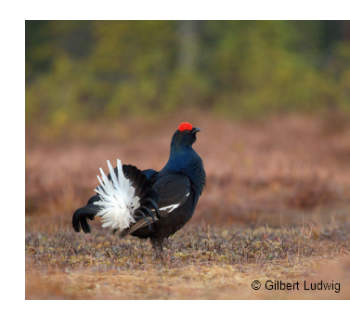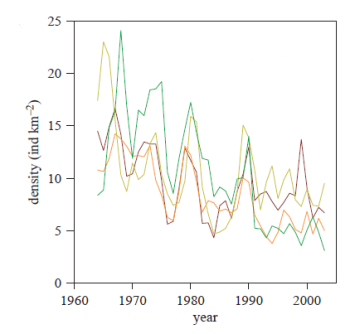Conservation of black grouse
 Globally, the black grouse is classed by the IUCN as lower risk (near
threatened). However, locally many black grouse populations are threatened and protected. In general, the large contiguous boreal populations stretching from Norway to Russa are not threatened, but in western and central Europe, black grouse numbers
have been declining rapidly during the 20th century, and
particularly since the 1970s. Many lowland populations have
disappeared and the remaining ones are mostly small (<100-
200 birds) and isolated (Storch 2007). In central
Europe, the largest and still mostly stable population is found
in the Alps, though this too is declining and becoming increasingly fragmented (Caizergues et al. 2003).
Globally, the black grouse is classed by the IUCN as lower risk (near
threatened). However, locally many black grouse populations are threatened and protected. In general, the large contiguous boreal populations stretching from Norway to Russa are not threatened, but in western and central Europe, black grouse numbers
have been declining rapidly during the 20th century, and
particularly since the 1970s. Many lowland populations have
disappeared and the remaining ones are mostly small (<100-
200 birds) and isolated (Storch 2007). In central
Europe, the largest and still mostly stable population is found
in the Alps, though this too is declining and becoming increasingly fragmented (Caizergues et al. 2003).
Black grouse became extinct in Denmark in the mid 1990s (Holst-Jørgensen 2000), whilst populations are down to <50 birds in both Belgium and the Netherlands (Jansman et al. 2004). In Germany and Poland, many local populations have disappeared. Conservation measures are ongoing, including habitat restoration, predator control, and reintroduction projects. In the UK, the total population is small 6000-7000 birds with the majority in Scotland. As a consequence the black grouse is listed as a biodiversity action plan (BAP) priority species.
The degree of legal protection varies among the range countries. In general, the species is fully and effectively protected in western and central European countries with small and declining populations. In other countries, e.g. Austria, Italy and France, hunting is strictly regulated and only allowed in certain areas and during limited hunting seasons. Illegal hunting still appears to be a problem in some regions.
 However, though black grouse populations in some areas are not seen as threatened, even in countries such as Finland, there have been long term declines. Therefore, effort should be made to monitor populations, even in areas where populations appear healthy.
This graph shows the long term decline in grouse populations from four different game districts in Finland. Image taken with permission from: Ludwig, G.X., Alatalo, R.V., Helle, P. Linden, H., Lindström, J. & Siitari, H. (2006) Short- and long-term population dynamical consequences of asymmetric climate change in black grouse. Proceedings of the Royal Society London Series B 273: 2009-2016.
However, though black grouse populations in some areas are not seen as threatened, even in countries such as Finland, there have been long term declines. Therefore, effort should be made to monitor populations, even in areas where populations appear healthy.
This graph shows the long term decline in grouse populations from four different game districts in Finland. Image taken with permission from: Ludwig, G.X., Alatalo, R.V., Helle, P. Linden, H., Lindström, J. & Siitari, H. (2006) Short- and long-term population dynamical consequences of asymmetric climate change in black grouse. Proceedings of the Royal Society London Series B 273: 2009-2016.
References
Caizergues, A., Rätti, O., Helle, P., Rotelli, L., Ellison, L. & Rasplus, J.-Y. (2003) Population genetic structure of male black grouse (Tetrao tetrix L.) in fragmented vs. continuous landscapes. Molecular Ecology, 12, 2297-2305.
Holst-Jørgensen, B. (2000) The black grouse in Denmark 1978– 2000. Cahiers d’Ethologie, 20,505-508.
Jansman, H.A.H., Niewold, F.J.J., Bovenschen, J. & Koelewijn, H.P. (2004) Korhoenders op de Sallandse Heuvelrug. Een populatie-genetische analyse van het wel en wee van Netherlands laatste populatie. Alterra-rapport 1122. Alterra, Wageningen
Ludwig, G.X., Alatalo, R.V., Helle, P. Linden, H., Lindström, J. & Siitari, H. (2006) Short- and long-term population dynamical consequences of asymmetric climate change in black grouse. Proceedings of the Royal Society London Series B, 273, 2009-2016.
Storch, I. (2007) Grouse: Status Survey and Conservation Action Plan 2006 –2010. Gland, Switzerland: IUCN and Fordingbridge, UK: World Pheasant Association. 114p.

